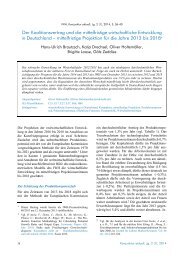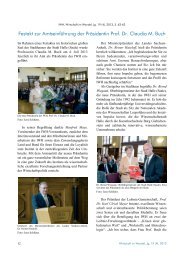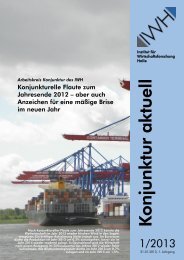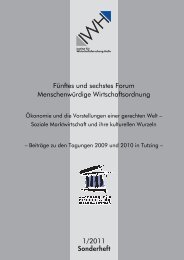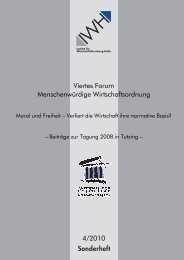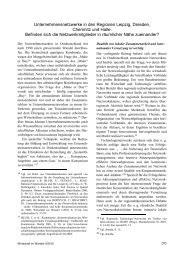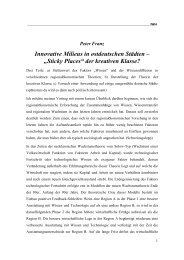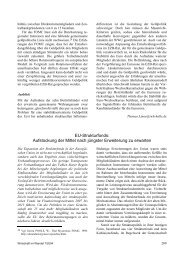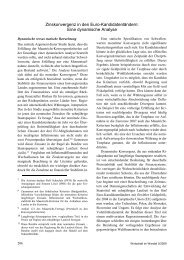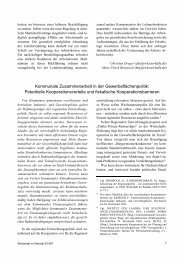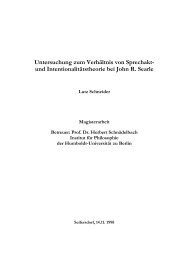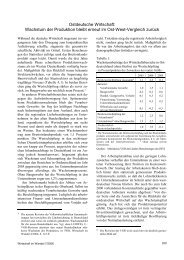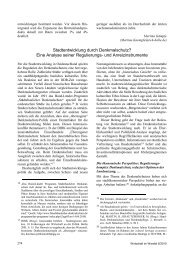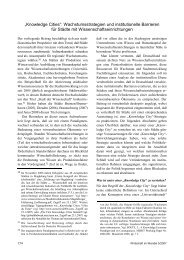Holger Zemanek: Bitte in dem anderne Paper die Anmerkungen von ...
Holger Zemanek: Bitte in dem anderne Paper die Anmerkungen von ...
Holger Zemanek: Bitte in dem anderne Paper die Anmerkungen von ...
You also want an ePaper? Increase the reach of your titles
YUMPU automatically turns print PDFs into web optimized ePapers that Google loves.
and Eastern European countries. 9 Additional to the Central and Eastern European EU member<br />
countries, we <strong>in</strong>clude Croatia as EU candidate country with data be<strong>in</strong>g available. Our data set<br />
covers the period from 1996 to 2008. The data prior to the year 1996 are very fragmented<br />
which limits the number of observations. We are aware of the fact that the degrees of freedom<br />
are low, but quarterly data are not available for sectoral productivity.<br />
Data sources are the IMF-IFS Database and the AMECO Database of the European<br />
Commission. Annual consumer price <strong>in</strong>flation data is from the IMF-IFS database. For euro<br />
area tradable goods <strong>in</strong>flation, we use German export price <strong>in</strong>flation as a proxy. 10 Nom<strong>in</strong>al<br />
exchange rate appreciations/depreciations vis-à-vis the euro are calculated from annual<br />
average exchange rate data from IMF-IFS. Exchange rates prior to the year 1999 are those<br />
vis-à-vis the German mark and have been converted <strong>in</strong>to euro based on the mark/euro<br />
conversion rate. With an eye on eq. (9), we expect that a nom<strong>in</strong>al appreciation (depreciation)<br />
lowers (<strong>in</strong>creases) domestic <strong>in</strong>flation <strong>in</strong> Central and Eastern Europe.<br />
We derive the relative productivity growth of tradable versus non-tradable goods from<br />
sectoral data on gross value added per person employed at constant prices (provided by the<br />
European Commission). The <strong>in</strong>dustry sector (ISIC sections C to E) is assumed to correspond<br />
to tradable goods while the service sector (ISIC sections G to P) and the construction sector<br />
(ISIC section F) are classified as non-tradable goods. Gross value added of services and<br />
construction are merged <strong>in</strong>to the non-tradable goods sector by weight<strong>in</strong>g them by the share of<br />
people employed <strong>in</strong> this sector. Then we compute change rates over time. On average across<br />
all 11 countries productivity growth <strong>in</strong> the tradable sector exceeds productivity growth <strong>in</strong> the<br />
non-tradable sector almost every year (Figure 1).<br />
We use several proxies of capital <strong>in</strong>flows from the IMF-IFS database. The f<strong>in</strong>ancial account<br />
balance as percent of GDP, the current account balance as percent of GDP (as proxy of<br />
recorded and unrecorded private capital and capital flows), net foreign asset accumulation of<br />
the monetary authority 11 , changes <strong>in</strong> foreign liabilities of domestic banks vs. foreign banks 12 ,<br />
and real <strong>in</strong>terest rate changes. As capital flows <strong>in</strong>, real <strong>in</strong>terest rates are expected to fall.<br />
9<br />
The respective countries are Bulgaria, Croatia, Czech Republic, Estonia, Hungary, Latvia, Lithuania, Poland,<br />
Romania, Slovak Republic, and Slovenia.<br />
10<br />
We use Germany as the benchmark because data for the euro area prior to 1999 are available.<br />
11<br />
Capital flows <strong>in</strong>to countries with fixed or managed exchange rates affect official reserves which have an<br />
impact on base money creation and credit growth.<br />
- 18 -



